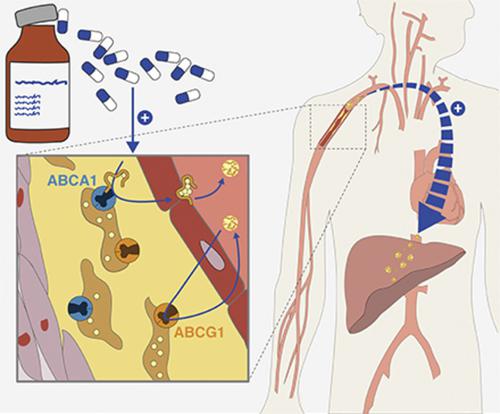当前位置:
X-MOL 学术
›
Pharmacol. Rev.
›
论文详情
Our official English website, www.x-mol.net, welcomes your feedback! (Note: you will need to create a separate account there.)
Brothers in Arms: ABCA1- and ABCG1-Mediated Cholesterol Efflux as Promising Targets in Cardiovascular Disease Treatment.
Pharmacological Reviews ( IF 21.1 ) Pub Date : 2020-01-01 , DOI: 10.1124/pr.119.017897 Sanne J C M Frambach 1 , Ria de Haas 1 , Jan A M Smeitink 1 , Gerard A Rongen 1 , Frans G M Russel 2 , Tom J J Schirris 2
Pharmacological Reviews ( IF 21.1 ) Pub Date : 2020-01-01 , DOI: 10.1124/pr.119.017897 Sanne J C M Frambach 1 , Ria de Haas 1 , Jan A M Smeitink 1 , Gerard A Rongen 1 , Frans G M Russel 2 , Tom J J Schirris 2
Affiliation

|
Atherosclerosis is a leading cause of cardiovascular disease worldwide, and hypercholesterolemia is a major risk factor. Preventive treatments mainly focus on the effective reduction of low-density lipoprotein cholesterol, but their therapeutic value is limited by the inability to completely normalize atherosclerotic risk, probably due to the disease complexity and multifactorial pathogenesis. Consequently, high-density lipoprotein cholesterol gained much interest, as it appeared to be cardioprotective due to its major role in reverse cholesterol transport (RCT). RCT facilitates removal of cholesterol from peripheral tissues, including atherosclerotic plaques, and its subsequent hepatic clearance into bile. Therefore, RCT is expected to limit plaque formation and progression. Cellular cholesterol efflux is initiated and propagated by the ATP-binding cassette (ABC) transporters ABCA1 and ABCG1. Their expression and function are expected to be rate-limiting for cholesterol efflux, which makes them interesting targets to stimulate RCT and lower atherosclerotic risk. This systematic review discusses the molecular mechanisms relevant for RCT and ABCA1 and ABCG1 function, followed by a critical overview of potential pharmacological strategies with small molecules to enhance cellular cholesterol efflux and RCT. These strategies include regulation of ABCA1 and ABCG1 expression, degradation, and mRNA stability. Various small molecules have been demonstrated to increase RCT, but the underlying mechanisms are often not completely understood and are rather unspecific, potentially causing adverse effects. Better understanding of these mechanisms could enable the development of safer drugs to increase RCT and provide more insight into its relation with atherosclerotic risk.
中文翻译:

兄弟般的兄弟:ABCA1和ABCG1介导的胆固醇外流是心血管疾病治疗中有希望的目标。
动脉粥样硬化是全世界心血管疾病的主要原因,高胆固醇血症是主要的危险因素。预防性治疗主要集中于有效降低低密度脂蛋白胆固醇,但其治疗价值受到无法完全归一化动脉粥样硬化风险的限制,这可能是由于疾病的复杂性和多因素发病机制所致。因此,高密度脂蛋白胆固醇引起了人们的极大兴趣,因为它在逆向胆固醇转运(RCT)中起主要作用,因此具有心脏保护作用。RCT有助于从周围组织(包括动脉粥样硬化斑块)中清除胆固醇,并随后将其清除为胆汁。因此,预期RCT会限制斑块的形成和发展。ATP结合盒(ABC)转运蛋白ABCA1和ABCG1启动并传播细胞胆固醇。预期它们的表达和功能将限制胆固醇外排,这使它们成为刺激RCT和降低动脉粥样硬化风险的有趣靶标。这篇系统的综述讨论了与RCT和ABCA1和ABCG1功能相关的分子机制,随后对小分子增强细胞胆固醇外排和RCT的潜在药理学策略进行了严格的综述。这些策略包括调节ABCA1和ABCG1的表达,降解和mRNA稳定性。各种小分子已被证明可以增加RCT,但是其潜在机制通常还不被完全理解,而且是非特异性的,有可能引起不良反应。
更新日期:2019-12-13
中文翻译:

兄弟般的兄弟:ABCA1和ABCG1介导的胆固醇外流是心血管疾病治疗中有希望的目标。
动脉粥样硬化是全世界心血管疾病的主要原因,高胆固醇血症是主要的危险因素。预防性治疗主要集中于有效降低低密度脂蛋白胆固醇,但其治疗价值受到无法完全归一化动脉粥样硬化风险的限制,这可能是由于疾病的复杂性和多因素发病机制所致。因此,高密度脂蛋白胆固醇引起了人们的极大兴趣,因为它在逆向胆固醇转运(RCT)中起主要作用,因此具有心脏保护作用。RCT有助于从周围组织(包括动脉粥样硬化斑块)中清除胆固醇,并随后将其清除为胆汁。因此,预期RCT会限制斑块的形成和发展。ATP结合盒(ABC)转运蛋白ABCA1和ABCG1启动并传播细胞胆固醇。预期它们的表达和功能将限制胆固醇外排,这使它们成为刺激RCT和降低动脉粥样硬化风险的有趣靶标。这篇系统的综述讨论了与RCT和ABCA1和ABCG1功能相关的分子机制,随后对小分子增强细胞胆固醇外排和RCT的潜在药理学策略进行了严格的综述。这些策略包括调节ABCA1和ABCG1的表达,降解和mRNA稳定性。各种小分子已被证明可以增加RCT,但是其潜在机制通常还不被完全理解,而且是非特异性的,有可能引起不良反应。



























 京公网安备 11010802027423号
京公网安备 11010802027423号